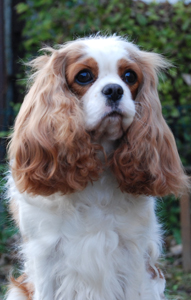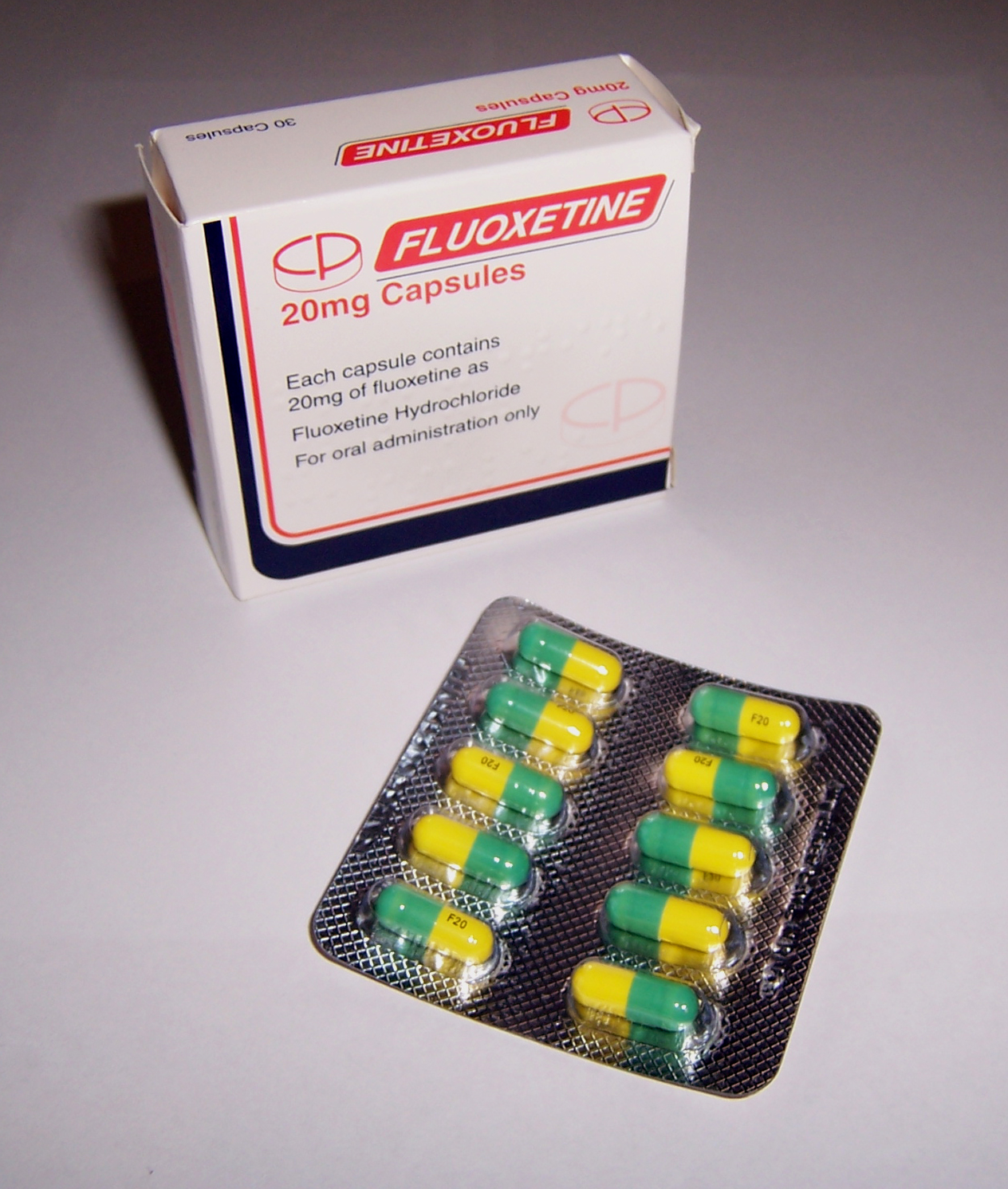|
Fly Biting
Fly biting (also called fly catching or fly snapping) refers to a type of dog behavior: episodes of intentional focused biting at the air, as if the dog is biting at imaginary flies. Cavalier King Charles Spaniels appear to be predisposed to fly catching syndrome, though it has been documented in many different breeds and mixes. Age of onset is varied. Fly biting is an uncommon idiopathic syndrome which is poorly understood. Theories on the cause include seizures, compulsive disorder, gastrointestinal conditions, and visual abnormalities. It appears that fly catching syndrome may be caused by more than one condition, and as a result, treatment is varied and unique to each situation. Episode characteristics Before an episode begins, dogs raise their heads and extend their necks and appear to focus on something in the air. Episodes may occur sporadically or at regular intervals, and consist of a varying number of snaps. These episodes may be accompanied by behavioral changes such ... [...More Info...] [...Related Items...] OR: [Wikipedia] [Google] [Baidu] |
Cavalier King Charles Spaniel
The Cavalier King Charles Spaniel is a British breed of toy dog of spaniel type. Four colours are recognised: Blenheim (chestnut and white), tricolour (black/white/tan), black and tan, and ruby; the coat is smooth and silky. The lifespan is usually between eight and twelve years. The Cavalier King Charles changed dramatically in the late seventeenth century, when it was inter-bred with flat-nosed breeds. Until the 1920s, it shared the same history as the smaller King Charles Spaniel. Breeders attempted to recreate what they considered to be the original configuration – a dog resembling Charles II's spaniel of the English Civil War period, when supporters of the king were known as Cavaliers. History During the early part of the 18th century, John Churchill, 1st Duke of Marlborough, kept red and white King Charles type spaniels for hunting. The duke recorded that they were able to keep up with a trotting horse. His estate was named Blenheim in honour of his victory at t ... [...More Info...] [...Related Items...] OR: [Wikipedia] [Google] [Baidu] |
Pica (disorder)
Pica is the eating or craving of things that are not food. It can be a disorder in itself or a sign of other cultural or medical phenomena. The ingested or craved substance may be biological, natural or manmade. The term was drawn directly from the medieval Latin word for magpie, a bird subject to much folklore regarding its opportunistic feeding behaviors. According to the '' Diagnostic and Statistical Manual of Mental Disorders, 5th Edition'' (DSM-5), pica as a standalone eating disorder must persist for more than one month at an age when eating such objects is considered developmentally inappropriate, not part of culturally sanctioned practice, and sufficiently severe to warrant clinical attention. Pica may lead to intoxication in children, which can result in an impairment of both physical and mental development. In addition, it can cause surgical emergencies to address intestinal obstructions, as well as more subtle symptoms such as nutritional deficiencies and parasitosis. ... [...More Info...] [...Related Items...] OR: [Wikipedia] [Google] [Baidu] |
Focal Seizure
Focal seizures (also called partial seizures and localized seizures) are seizures which affect initially only one hemisphere of the brain. The brain is divided into two hemispheres, each consisting of four lobes – the frontal, temporal, parietal and occipital lobes. A focal seizure is generated in and affects just one part of the brain – a whole hemisphere or part of a lobe. Symptoms will vary according to where the seizure occurs. When seizures occur in the frontal lobe the patient may experience a wave-like sensation in the head. When seizures occur in the temporal lobe, a feeling of déjà vu may be experienced. When seizures are localized to the parietal lobe, a numbness or tingling may occur. With seizures occurring in the occipital lobe, visual disturbances or hallucinations have been reported. , Epilepsy S ... [...More Info...] [...Related Items...] OR: [Wikipedia] [Google] [Baidu] |
Canine Lick Granuloma
{{disambiguation ...
Canine may refer to: Zoology and anatomy * a dog-like Canid animal in the subfamily Caninae ** ''Canis'', a genus including dogs, wolves, coyotes, and jackals ** Dog, the domestic dog * Canine tooth, in mammalian oral anatomy People with the surname * Henry Canine (), American football coach * Ralph Canine (1895–1969), founding director of the United States National Security Agency Other uses * Canine, a fictional dog in the ''Glenn Martin, DDS'' animated television series * Canine Hills, Antarctic landform in the Bowers Mountains, Victoria Land See also * K9 (other) * Kanine (other) * Canina (other) * Cani (other) * List of canids Canidae is a family of mammals in the order Carnivora, which includes domestic dogs, wolves, coyotes, foxes, jackals, dingoes, and many other extant and extinct dog-like mammals. A member of this family is called a canid; all extant species are a ... [...More Info...] [...Related Items...] OR: [Wikipedia] [Google] [Baidu] |
Obsessive–compulsive Disorder
Obsessive–compulsive disorder (OCD) is a mental and behavioral disorder in which an individual has intrusive thoughts and/or feels the need to perform certain routines repeatedly to the extent where it induces distress or impairs general function. As indicated by the disorder's name, the primary symptoms of OCD are obsessions and compulsions. Obsessions are persistent unwanted thoughts, mental images, or urges that generate feelings of anxiety, disgust, or discomfort. Common obsessions include fear of contamination, obsession with symmetry, and intrusive thoughts about religion, sex, and harm. Compulsions are repeated actions or routines that occur in response to obsessions. Common compulsions include excessive hand washing, cleaning, counting, ordering, hoarding, neutralizing, seeking assurance, and checking things. Washing is in response to the fear of contamination. Ordering is the preference for tasks to be completed a specific way (e.g., organizing clothes a specific w ... [...More Info...] [...Related Items...] OR: [Wikipedia] [Google] [Baidu] |
Synchysis Scintillans
Synchysis scintillans is a degenerative condition of the eye resulting in liquefied vitreous humor and the accumulation of cholesterol crystals within the vitreous. It is also known as cholesterolosis bulbi. The vitreous liquifies in a process known as syneresis. Synchysis scintillans appears as small white floaters that freely move in the posterior part of the eye, giving a snow globe effect. It is most commonly seen in eyes that have suffered from a degenerative disease and are end-stage. The condition is seen rarely. Associated with the advanced stages of diabetic retinopathy Diabetic retinopathy (also known as diabetic eye disease), is a medical condition in which damage occurs to the retina due to diabetes mellitus. It is a leading cause of blindness in developed countries. Diabetic retinopathy affects up to 80 perc ..., but the exact pathogenesis is unknown. The condition is symptomless and untreatable. In ophthalmoscopic examination it appears as small, flat, yellow ... [...More Info...] [...Related Items...] OR: [Wikipedia] [Google] [Baidu] |
Floater
Floaters or eye floaters are sometimes visible deposits (e.g., the shadows of tiny structures of protein or other cell debris projected onto the retina) within the eye's vitreous humour ("the vitreous"), which is normally transparent, or between the vitreous and retina.Cline D; Hofstetter HW; Griffin JR. ''Dictionary of Visual Science''. 4th ed. Butterworth-Heinemann, Boston 1997. They can become particularly noticeable when looking at a blank surface or an open monochromatic space, such as blue sky. Each floater can be measured by its size, shape, consistency, refractive index, and motility. They are also called ''muscae volitantes'' (Latin for 'flying flies'), or ''mouches volantes'' (from the same phrase in French). The vitreous usually starts out transparent, but imperfections may gradually develop as one ages. The common type of floater, present in most people's eyes, is due to these degenerative changes of the vitreous. The perception of floaters, which may be annoying ... [...More Info...] [...Related Items...] OR: [Wikipedia] [Google] [Baidu] |
Phenobarbital
Phenobarbital, also known as phenobarbitone or phenobarb, sold under the brand name Luminal among others, is a medication of the barbiturate type. It is recommended by the World Health Organization (WHO) for the treatment of certain types of epilepsy in developing countries. In the developed world, it is commonly used to treat seizures in young children, while other medications are generally used in older children and adults. In developed countries it is used for veterinary purposes. It may be used intravenously, injected into a muscle, or taken by mouth. The injectable form may be used to treat status epilepticus. Phenobarbital is occasionally used to treat trouble sleeping, anxiety, and drug withdrawal and to help with surgery. It usually begins working within five minutes when used intravenously and half an hour when administered by mouth. Its effects last for between four hours and two days. Side effects include a decreased level of consciousness along with a decreased ef ... [...More Info...] [...Related Items...] OR: [Wikipedia] [Google] [Baidu] |
Fluoxetine
Fluoxetine, sold under the brand names Prozac and Sarafem, among others, is an antidepressant of the selective serotonin reuptake inhibitor (SSRI) class. It is used for the treatment of major depressive disorder, obsessive–compulsive disorder (OCD), bulimia nervosa, panic disorder, and premenstrual dysphoric disorder. It is also approved for treatment of major depressive disorder in adolescents and children 8 years of age and over. It has also been used to treat premature ejaculation. Fluoxetine is taken by mouth. Common side effects include indigestion, trouble sleeping, sexual dysfunction, loss of appetite, dry mouth, and rash. Serious side effects include serotonin syndrome, mania, seizures, an increased risk of suicidal behavior in people under 25 years old, and an increased risk of bleeding. Antidepressant discontinuation syndrome is less likely to occur with fluoxetine than with other antidepressants, but it still happens in many cases. Fluoxetine taken during pregnan ... [...More Info...] [...Related Items...] OR: [Wikipedia] [Google] [Baidu] |





